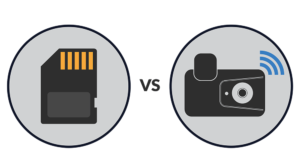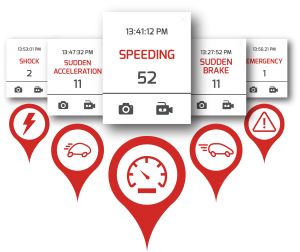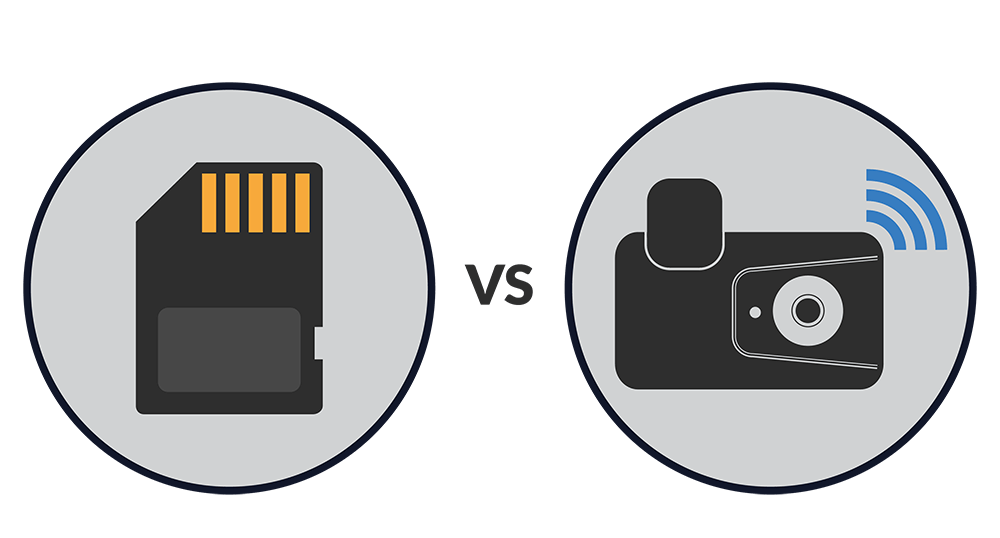SD-CARD VERSUS CONNECTED VEHICLE CAMERAS – THE TOP TEN DIFFERENCES
Written by VisionTrack
30 January 2019

Many businesses now recognise the need for a vehicle camera solution to help better protect their fleet, staff and reputation, but what is sometimes less clear is whether to invest in SD-card or connected (3G/4G) technology. With this in mind, we have outlined below the top ten differences between these vehicle camera options:
1. ACCESSIBILITY
An SD-card vehicle camera requires footage to be manually downloaded via a reader on a computer before it can be viewed, making it difficult and time-consuming to manage if a fleet has more than a handful of vehicles. A connected vehicle camera device instead uploads video and supporting data immediately to an online portal, as well as sending an email so a company has instant visibility of what has taken place.
2. RELIABILITY
SD cards can suffer from corruption when not formatted on a regular basis. Fleets using an SD-card vehicle camera often only check when the worst has happened, and a vehicle has been involved in a serious incident, which can be too late. With a connected vehicle camera device, remote diagnostics provide complete visibility and peace of mind as any issues can be quickly identified and resolved.
3. LOST FOOTAGE
Data corruption, driver interference and even police action can all result in a fleet not being able to access footage from an SD-card vehicle camera that is needed to determine liability and manage the resulting insurance claim. As a connected vehicle camera device immediately uploads video footage following a collision, a company has instant access. Video on demand also enables a company to download footage remotely for any time period if, for example, a vehicle has been impounded by the police as part of an ongoing investigation.
4. MAINTENANCE
There are some providers of SD-card vehicle cameras that recommend that all devices are routinely checked to ensure they are working correctly. This could be as regularly as every 4-6 weeks, creating added time and administrative burden on a business’ maintenance function. In contrast, a connected vehicle camera device can be monitored remotely with health checks, SD-card reformatting and even software updates handled over the air. Therefore, maintenance resources can be used cost-effectively.
5. TAMPER-PROOF
A lockable case discourages a driver from removing or damaging an SD-card, regardless of what type of vehicle camera is in use. However, the best deterrent is the knowledge that video footage is being automatically uploaded to an online portal when a collision occurs, giving connected vehicle cameras a clear advantage over SD-card vehicle cameras. By making any attempt to tamper with a device completely meaningless, it is possible to eliminate unauthorised intervention and reduce the risk of equipment damage.
6. FIRST NOTIFICATION OF LOSS (FNOL)
Having immediate access to video footage and supporting data in the event of a collision means that fleets can take advantage of First Notification of Loss (FNOL) and achieve effective Third Party Intervention (TPI). As such, connected vehicle camera devices allow an insurance partner or in-house team to take control of the claims handling process to prevent excessive third-party hire and repair costs, while discouraging exaggerated injury claims.

7. DRIVER BEHAVIOUR MONITORING

Vehicle cameras can capture a wide range of driver behaviour data such as harsh driving events – braking, acceleration and cornering – and speeding. With SD-card devices it is simply not viable to collate all the data in any meaningful way, because the time and cost impact would be far too great. A connected vehicle camera device can be set up to automatically capture and communicate this data in-real-time, so drivers can be compared at the touch of a button. As a result, there is a clear opportunity to improve fleet safety through improved and targeted driver engagement.
8. LONE WORKER PROTECTION
When using a SD-card vehicle camera, there is no way to monitor the welfare of a driver without integrating the device with a compatible telematics system (even then there is often only limited alert functionality available). Connected vehicle camera provides real-time notifications regarding any serious incident, with a supporting snapshot and/or video footage, so it is possible to immediately determine the severity of an incident and if a driver is at risk of injury (alleged incidents can also be investigated by accessing video on demand). A device can also include a built-in panic button, so a driver can raise an alarm and request assistance.
9. TRACKING DATA
Due to the connected nature of 3G/4G vehicle cameras, a business can access simple tracking data from the use of this kind of fleet technology. As a result, there is an added benefit over a SD-card vehicle camera solution with the ability to pinpoint the exact whereabouts of all vehicles and their real-time status. A connected device can either work alongside and complement an existing vehicle tracking system or operate as standalone solution.
10. COST AND ROI
While the initial outlay for a connected video CCTV device is higher than a SD-card vehicle camera, VisionTrack has calculated (working closely with customers) that it is actually works out 50% cheaper to adopt a 3G/4G solution for a fleet of 100 vehicles.
The return on investment is also much great, with additional insurance savings and road safety improvements alone considerable This is before you in less tangible benefits such as brand protection and reduced wear and tear. Meanwhile, the need to bring vehicles back to base to either recover footage or reformat an SD-card device can also result in added maintenance costs, lost productivity and unnecessary mileage and business interruption.
VisionTrack is the leader in connected vehicle cameras and video telematics. Our innovative solutions are proven to deliver true value to any size of fleet operations including reduced insurance costs, improved road safety, lower operational risk, increased fleet efficiency and enhanced duty of care. If you are still not quite sure what is the best option for your fleet or you would like to learn more about our vehicle camera and video telematics solutions, then get in touch with us today for a chat with one of our team.
If you would like information on any of VisionTrack’s services or products, you can email info@localhost or call 01246 225 745.




